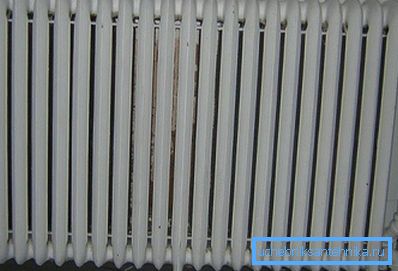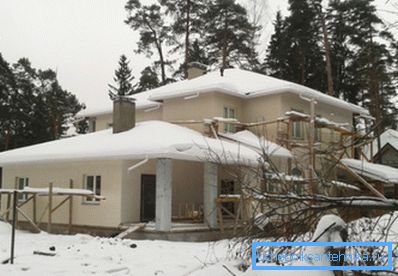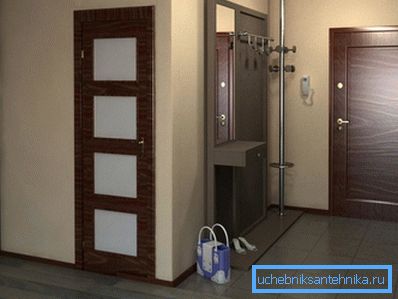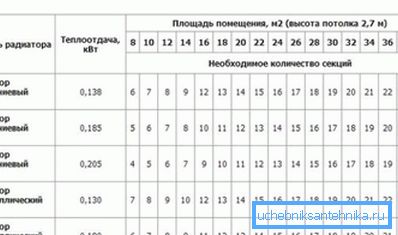Calculation of heating devices: simple schemes
How to calculate the parameters of the heater for a room with known characteristics? In this article, we are going to get acquainted with several simple schemes that provide acceptable accuracy of the results. We will not climb into the jungle: all calculations can be done by hand with a person who is far from heat engineering. So go.

What we think
Let's break the big task into small stages.
We need:
- Learn to assess the need of the room in heat.
Note: it is better to have calculation schemes in your arsenal for both houses with normalized resistance to heat transfer, and for buildings with significantly better or worse quality insulation.
- Learn how to recalculate the heating power of the heater in the number of sections of the radiator.
- Find out how to estimate the power of devices not consisting of standard sections.
In this order, and move on.
Thermal power
We give two ways to evaluate it.
For normalized thermal resistance
For buildings that meet the requirements of SNiP 23-02-2003 Thermal protection of buildings, the need for heat can be calculated according to the following scheme:
- The base value is taken equal to 40 watts per cubic meter of a heated room or apartment.
- It is multiplied by a factor depending on the placement of the room.
| Location | Coefficient |
| Corner (two common walls with the street) | 1.2 |
| End (three common walls with the street) | 1,3 |
| Private house (all fencing structures are in contact with the street) | 1.5 |

- 100 watts of heat are added to each standard-sized window, and 200 to the door leading to the street.
- A regional coefficient is introduced.
| Region | Coefficient |
| Sochi, Yalta | 0.7 |
| Moscow, Petersburg | 1.2 |
| Irkutsk, Khabarovsk | 1.6 |
| Verkhoyansk, Oymyakon | 2.0 |
Let's calculate the need for thermal heating power for a room with dimensions of 4 * 5 * 3 meters in the city of Komsomolsk-on-Amur of the Khabarovsk Territory.
The room is corner with two windows.
- 40 watts per cube give 40 * 4 * 5 * 3 = 2400 watts.
- Since the room is angular, we use a factor of 1.2. 2400 * 1.2 = 2880.
- A pair of windows will exacerbate the situation. 2880+ (2 * 100) = 3080 watts.
- The climate zone will make its own adjustments. 3080 * 1.6 = 4928 watts.
Nuance: if the apartment has rooms without heating appliances, their volume should also be taken into account when calculating. So, if a corridor with the size of 4 * 1 * 3 meters adjoins to our room, the thermal power needs to be calculated for (4 * 5 * 3) + (4 * 1 * 3) = 72 m3 of the heated room.

For non-standard warming
If the quality of insulation is much better or worse than the recommended SNiP, the formula Q = V * Dt * K / 860 is used to estimate the need for heat, in which:
- Q - cherished power in kilowatts.
- V is the volume of the room in cubic meters.
- Dt is the maximum temperature difference between indoor and outdoor air.
- K - coefficient of insulation. Its value can be estimated approximately, being guided by the following table:
| Description of enclosing structures | Coefficient |
| 12 cm thick brickwork in one thread | 3 - 4 |
| Brick wall 25 cm thick, wooden window frames | 2 - 2.9 |
| Brick laying in one and a half brick (38 cm), single-chamber double-glazed windows | 1 - 1.9 |
| Mineral-cotton or foam exterior insulation, two-chamber double-glazed windows with energy-saving glass | 0.6 - 0.9 |
The parameter Dt is usually taken equal to the difference between the internal temperature values recommended by the SNiP and the average minimum of the coldest month in the last few years. Focusing on the absolute minimum will be some sorting out: if, say, in the Crimea it happens to be -25, then only once every few years for one or two days.
Let's calculate the thermal power of the same room in Komsomolsk-on-Amur, specifying that the windows in it are equipped with double-glazed windows, and the thickness of the brick walls is 60 centimeters.

- The volume of the room is 4 * 5 * 3 = 60 m3.
- The minimum room temperature for a corner room in this climatic zone fixed by SNiP is +22 C.
- The average minimum of January is -30.8 C.
- We take the coefficient of heat insulation equal to 0.8.
The calculation of heating devices for our room will look like Q = 60 * (22 - -30.8) * 0.8 / 860 = 2.94 kW. It is easy to see that the spread with the first result is quite large.
Devices
Instructions for the selection of a plate, tubular radiator or convector heating is extremely simple: it is enough to study the documentation for the device. Manufacturers always indicate heat output for a standard delta temperature between the coolant and the air at 70 degrees.

Please note: halving the delta temperature (say, at +20 in a room and a battery temperature of +55 C) will inevitably entail a two-fold drop in power.
In the accompanying documents and on the manufacturer's website, you can, as a rule, find the values of heat flow for individual sections of the sectional radiator.
In the absence of documentation, you can focus on the following average values:
- Cast iron section - 160 watts.
- Bimetallic section - 180 watts.
- Aluminum section - 200 watts.
So, to obtain thermal power of 2940 watts, 2940/180 = 17 (rounding up) bimetallic sections is sufficient.
Useful: radiators of this length need to be connected diagonally or bottom to bottom. Otherwise, the entire coolant will circulate only through the first sections.

A special case
The low price makes it very attractive to use a steel pipe register. However, homemade designs usually lack technical documentation.
How to perform the calculation in this case?
- Heat output of one horizontal pipe in watts is calculated as Q = 3.1415 * Dн * L * 11.63 * Dt. In it, DN is the outer diameter of the pipe (in meters); L is its length in meters, Dt is the delta of temperatures between the air and the coolant.
- The heat output of the other sections of the register located above this pipe is calculated in the same way, but using an additional factor of 0.9.
So, with an outer diameter of 208 mm, a length of 3 meters and a delta temperature of 70 ° C, the power of the two-section register will be (3.1415 * 0.2008 * 3 * 11.63 * 70) + (3.1415 * 0.2008 * 3 * 11.63 * 70) * 0.9 = 1596 + 1436 = 3032 watts.

Conclusion
Again: we have shown the simplest schemes of approximate calculations, unsuitable for professional use, but giving fairly accurate results. As always, the attached video will offer the reader additional materials. Successes!